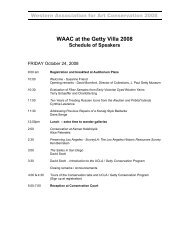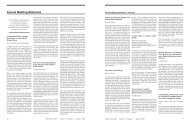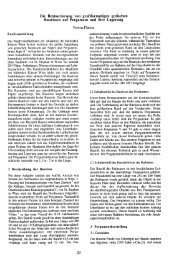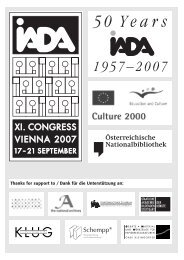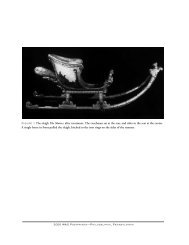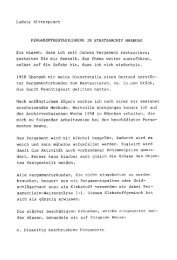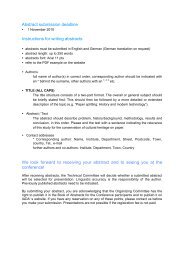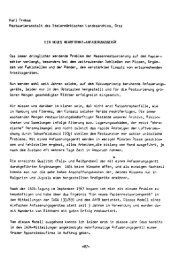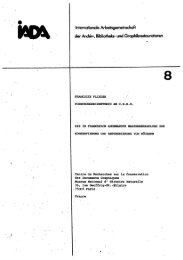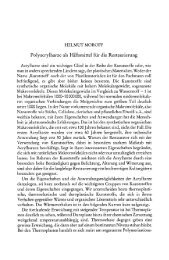Maintenance of Asian Paintings II: Minor Treatment of Scroll Paintings
Maintenance of Asian Paintings II: Minor Treatment of Scroll Paintings
Maintenance of Asian Paintings II: Minor Treatment of Scroll Paintings
You also want an ePaper? Increase the reach of your titles
YUMPU automatically turns print PDFs into web optimized ePapers that Google loves.
A B S T R AC T<br />
This paper describes minor or local treatments that can<br />
extend the life <strong>of</strong> <strong>Asian</strong> scroll paintings, reduce the risk <strong>of</strong><br />
damage, and minimize further deterioration: repair <strong>of</strong><br />
creases, small losses, tears, and damaged cords. It is a<br />
sequel to a paper presented in 1993, “<strong>Maintenance</strong> <strong>of</strong> East<br />
<strong>Asian</strong> Painting (Examination),” published in the Book and<br />
Paper Group Annual.<br />
I N T R O D U C T I O N<br />
<strong>Maintenance</strong> <strong>of</strong> <strong>Asian</strong> <strong>Paintings</strong> <strong>II</strong>:<br />
<strong>Minor</strong> <strong>Treatment</strong> <strong>of</strong> <strong>Scroll</strong> Pa i n t i n g s<br />
<strong>Scroll</strong> mounting is a unique craft in Asia. <strong>Paintings</strong> on<br />
scrolls represent a narrative literature with pictures and<br />
were mounted in traditional formats (religious sutras were<br />
traditionally mounted as hand scrolls). Artists and calligraphers<br />
created their works expecting them to be in a<br />
particular, traditional final format.<br />
Japanese scroll mountings (h y o g u) were also living,<br />
functional objects. In serving their intended function they<br />
experience normal wear and tear. In the <strong>Asian</strong> tradition<br />
their functional parts have always been replaced periodically<br />
with new, stronger materials. When a scroll starts to<br />
have tears and creases, this is the signal for a complete<br />
remounting. When border silk or backing/lining paper<br />
loses strength and starts to tear, it will be replaced, just like<br />
replacing the sound board or strings <strong>of</strong> a piano, replacing<br />
the cover <strong>of</strong> a book or replacing old moldings or even the<br />
original paint <strong>of</strong> historical houses. <strong>Scroll</strong> makers will also<br />
touch up minor flaws in the art object.<br />
Each time an object is remounted, it is traditional to<br />
allow individual taste and the availability <strong>of</strong> new materials<br />
to play a large part in deciding how to remount the work.<br />
In Asia, modern conservation is based on this tradition.<br />
The practice <strong>of</strong> completely remounting hanging scrolls<br />
Presented at the Book & Paper Group Session, AIC 29th Annual<br />
Meeting, May 30–June 5, 2001, Dallas, Texas. Received for publication<br />
Fall 2001.<br />
YO S H I Y U K I N I S H I O<br />
The Book and Paper Group Annual 20 (2001) 15<br />
continues, much like rebuilding furniture or musical<br />
instruments. Of course we would not rebuild the main<br />
parts <strong>of</strong> paintings or calligraphy, but a fair degree <strong>of</strong> freedom<br />
in remounting is allowed—sufficiently so that I hope<br />
that the craft <strong>of</strong> scroll mounting will come in time to be<br />
viewed as an art form in its own right.<br />
The <strong>Asian</strong> approach to remounting is in some tension<br />
with the concept <strong>of</strong> modern conservation as developed in<br />
the West. Modern conservation ethics train conservators<br />
(especially those working in museums or other institutions)<br />
to keep the original materials as much as possible to<br />
preserve historical objects. These conservators recognize,<br />
however, that keeping deteriorated or dysfunctional parts<br />
may diminish or obscure the real meaning or purpose <strong>of</strong><br />
the objects.<br />
This paper primarily addresses what I consider a special,<br />
but sometimes neglected, class <strong>of</strong> conservation activities:<br />
touch-ups and minor treatments <strong>of</strong> objects. <strong>Minor</strong> treatments<br />
form a major part <strong>of</strong> ongoing conservation activity.<br />
<strong>Minor</strong> treatments can also be cost-effective. While some<br />
objects may need a complete treatment, <strong>of</strong>ten the best<br />
approach is minimum minor treatment and a strict monitoring<br />
system, to check for further deterioration.<br />
Major conservation always involves some risks. If a<br />
painting has been subjected to periodic minor treatments,<br />
it is less likely to need a major treatment or the need for a<br />
major operation can be postponed, and therefore the risk<br />
<strong>of</strong> significant harm is reduced over the long-term life <strong>of</strong><br />
the painting.<br />
Since I became a conservator, I have <strong>of</strong>ten been called<br />
upon to perform minor treatments at various sites. Many<br />
<strong>Asian</strong> paintings in storage and even on display are <strong>of</strong>ten<br />
neglected, mainly because <strong>of</strong> the shortage <strong>of</strong> conservators<br />
<strong>of</strong> <strong>Asian</strong> paintings. Most minor treatment activities are<br />
things I never learned from other people. I developed the<br />
concepts and methods on my own, and I would like to<br />
share them in this paper. I hope that you will get your own<br />
ideas from it and develop your own ways for treating <strong>Asian</strong><br />
paintings in your collection or your client’s.
16 The Book and Paper Group Annual 20 (2001)<br />
Fig. 1. Horizontal creases on a Chinese<br />
scroll, recto<br />
R E C O G N I Z I N G D E T E R I O R AT I O N<br />
As I discussed in the first part <strong>of</strong> this paper ten years ago<br />
(Nishio 1993), the following indications <strong>of</strong> deterioration<br />
are commonly found in hanging scrolls: creases, losses,<br />
tears, and damaged cords.<br />
C R E A S E S<br />
The most common types <strong>of</strong> deterioration in scroll<br />
paintings are horizontal creases and cracks (figs.1–5).<br />
<strong>Scroll</strong>s are constructed with at least three to four layers <strong>of</strong><br />
lining or backing paper. The original primary support is<br />
usually very thin and supported with multiple layers <strong>of</strong><br />
Japanese or Chinese paper. If the scroll is kept rolled for a<br />
long time the fibers <strong>of</strong> the paper may break when it is<br />
opened, causing creases and cracks. Of course if there are<br />
many cracks (fig. 5), it is easier to remove and replace the<br />
Fig. 2. Horizontal creases on a Chinese<br />
scroll, verso Fig. 3. There is one severe crease on this<br />
Ming Dynasty scroll<br />
whole outer backing<br />
l a y e r. This requires a<br />
high degree <strong>of</strong> skill.<br />
H o w e v e r, if there are<br />
only a few cracks, you<br />
can remove the outer<br />
layer <strong>of</strong> the lining<br />
locally by cutting and<br />
delaminating with<br />
scalpels.<br />
Figures 6–7 g i v e<br />
schematic diagrams <strong>of</strong><br />
the layers <strong>of</strong> a scroll<br />
with a crease/crack.<br />
1. Multiple layers <strong>of</strong><br />
paper in cross-sec-<br />
Fig. 4. Detail <strong>of</strong> the crease on the<br />
Ming Dynasty scroll
Nishio <strong>Maintenance</strong> <strong>of</strong> <strong>Asian</strong> <strong>Paintings</strong> <strong>II</strong>: <strong>Minor</strong> treatment <strong>of</strong> <strong>Scroll</strong> <strong>Paintings</strong> 17<br />
tion. The original primary support is usually very thin<br />
gampi or Chinese paper supported or lined with multiple<br />
layers <strong>of</strong> kozo fiber paper for Japanese hanging<br />
scrolls. Chinese lining paper is used for Chinese hanging<br />
scrolls. Replacing some <strong>of</strong> the creased backing layers<br />
can eliminate the cracks. However, replacement <strong>of</strong> all<br />
layers can cause unevenness and distortion <strong>of</strong> the surface.<br />
Therefore, I would replace only the outermost<br />
layer and apply an additional reinforcement strip <strong>of</strong> narrow<br />
(only one-eighth inch) but strong and flexible<br />
u s u m i n o p a p e r, crossing the fiber direction between the<br />
interleaf lining layers and the new outer layer <strong>of</strong> the u d a<br />
paper. Before doing so the whole painting must be<br />
Fig. 5. <strong>Scroll</strong> with many creases<br />
Figs. 6–7. Diagrams <strong>of</strong> the layers <strong>of</strong> a scroll with a crease/crack;<br />
numbers in the margin refer to explication in the text.
18 The Book and Paper Group Annual 20 (2001)<br />
Fig. 8. Futomaki Fig 9. Futomaki used to increase the diameter <strong>of</strong> a scroll roller<br />
placed on a protecting sheet <strong>of</strong> non-sticking but moisture-absorbent<br />
paper.<br />
2. A narrow area (about one-eight inch wide) <strong>of</strong> the outer<br />
backing layer along the crease is removed with a scalpel<br />
and tweezers.<br />
3 . The crease is moistened lightly with a brush to flatten it<br />
and expand it to match the pasted reinforcement strip,<br />
so the layers will shrink together when they dry.<br />
4. A pasted usumino reinforcing strip is set in place aiming<br />
right in the middle to cover the crack or crease.<br />
5. Cover the area with uda paper using diluted paste and<br />
pound with a tiny bristle brush.<br />
The pasted strip and lining paper are always pasted with<br />
thinly diluted paste. Since those materials are wet, the<br />
crease must be moistened and flattened to match the same<br />
shrinkage ratio with the new additional materials. If not,<br />
the area will dry in a distorted fashion. I have seen many<br />
Western paper conservators using water cut or feather cut<br />
p a p e r, but those feathers or “sticking out” fibers tend to<br />
hold too much paste and moisture, which will cause<br />
unevenness. It is better to use a straight knife-cut strip and<br />
keep the overlap to just a hairline. If the overlap is only one<br />
m i l l i m e t e r, it is not noticeable and does not cause future<br />
creases, because the diameter <strong>of</strong> the scroll is much larger<br />
than the unevenness <strong>of</strong> the one-millimeter overlap. If you<br />
wish to be even more precise, you can always pare the<br />
edges <strong>of</strong> the straight knife cut in the overlapping area with<br />
a scalpel.<br />
You must also be careful about the thickness <strong>of</strong> the<br />
paste. Thickly applied paste can cause stiffness, water rings,<br />
glossiness, and changes in surface texture. If you ever have<br />
to use feather-cut edges, you must remove at least half <strong>of</strong><br />
the paste or moisture by blotting with other paper.<br />
6. After the application <strong>of</strong> local reinforcement strips and<br />
lining paper, the area has to dry under blotting paper<br />
and Plexiglas or on a flat wooden board under a weight<br />
for a few days. The sharp edges are shaved and the new<br />
uda paper is toned and dried some more. Finally, after<br />
it is dry, rub or burnish a Te flon spatula or beads, which<br />
I use, along the flattened crease to s<strong>of</strong>ten the paper.<br />
The fact that some creases and cracks occurred is a sign<br />
that other areas might crack in the future. To help postpone<br />
this, you should use a wider rolling accessory. This<br />
device is called futomaki, made <strong>of</strong> pawlonia wood (figs. 8–<br />
9). Carpenters can make it with a little study from the real<br />
futomaki, but if not, you can order it from Japan. Japanese<br />
Fig. 10. The upper side edges <strong>of</strong> this scroll show small losses
Nishio <strong>Maintenance</strong> <strong>of</strong> <strong>Asian</strong> <strong>Paintings</strong> <strong>II</strong>: <strong>Minor</strong> treatment <strong>of</strong> <strong>Scroll</strong> <strong>Paintings</strong> 19<br />
paper shops/vendors either in the United States or Japan<br />
might be able to fill an order for you.<br />
F I L L I N G L O SS E S<br />
Figures 10–11 show scrolls with fringes (small losses) at<br />
the upper side edges. Figures 12–13 present schematic<br />
drawings <strong>of</strong> a cross-section <strong>of</strong> scroll with a loss.<br />
1. Because <strong>of</strong> wear and tear, the edges <strong>of</strong> a scroll can sometimes<br />
become abraded, torn, or lost.<br />
2. The outer layer <strong>of</strong> u d a and interleaf <strong>of</strong> m i s u a r e<br />
removed.<br />
3. Usumino paper is inserted and pasted with very diluted<br />
paste, and then the whole scroll is flipped face up.<br />
4 and 5. New similar brocade or plain silk with backing<br />
paper is inserted flush on the level <strong>of</strong> the existing silk<br />
brocade.<br />
6. The painting is turned face down. The edge <strong>of</strong> the new<br />
inserted part is cut and folded just like the rest <strong>of</strong> the<br />
scroll and pasted.<br />
7. Application <strong>of</strong> one-eighth-inch usumino reinforcement<br />
strips. (This reinforcement strip is not done if the<br />
break is vertical, only if the broken edge is horizontal).<br />
8. U d a paper covers the rest <strong>of</strong> the newly reconstructed<br />
area.<br />
Fig. 11. The upper side edges <strong>of</strong> this scroll show small losses<br />
Figs. 12–13. Diagrams <strong>of</strong> a cross-section <strong>of</strong> a scroll with a loss;<br />
numbers in the margin refer to explication in the text.
20 The Book and Paper Group Annual 20 (2001)<br />
Fig. 14. Chinese scroll with a tear at the bottom<br />
When it is dry, the uda paper can be shaved to remove<br />
the overlapping edge on the left. The right side <strong>of</strong> the edge<br />
has to be cut straight just like the rest <strong>of</strong> the scroll. Then<br />
toning can be done with watercolor followed by further<br />
drying. Again this area has to be burnished with a Teflon<br />
spatula or beads.<br />
Fig. 15. Japanese scroll with a tear at the bottom<br />
Figs. 16–17. Diagrams <strong>of</strong> a cross-section <strong>of</strong> a scroll with a tear
Nishio <strong>Maintenance</strong> <strong>of</strong> <strong>Asian</strong> <strong>Paintings</strong> <strong>II</strong>: <strong>Minor</strong> treatment <strong>of</strong> <strong>Scroll</strong> <strong>Paintings</strong> 21<br />
T E A R S<br />
Tears occur always near the bottom and top rods (figs.<br />
14–15). The following procedure is performed (figs.<br />
16–17).<br />
1. Cross-section <strong>of</strong> rod (layers <strong>of</strong> paper are actually much<br />
thinner compared to the cross-section <strong>of</strong> the rod than<br />
the drawing shows). Remove the bottom rod by using<br />
a spatula to separate the two pasted areas. These areas<br />
usually have relatively thick paste so you may have to<br />
use some moisture.<br />
2. The layers look like this after you remove the rod.<br />
3. The jiku-bukuro or envelope is separated from the rest.<br />
The tiny area at the arrow marked “pasted” in diagram<br />
1 is sometimes pasted and separated front and back.<br />
4. Parts <strong>of</strong> the interleaf (m i s u paper) and backing paper<br />
(uda paper) have been removed.<br />
5. An usumino strip is used to mend the tear <strong>of</strong> the lined<br />
silk from verso.<br />
6. The j i k u - b u k u r o with partial outer backing paper is reinstalled<br />
on the back with dryer paste, about one-eighth<br />
inch along the edge.<br />
7. New u d a paper is installed. The area must then be dried<br />
for several days.<br />
Figs. 18–19. The front part <strong>of</strong> the silk is pasted to cover the rest<br />
<strong>of</strong> the rod
22 The Book and Paper Group Annual 20 (2001)<br />
Fig. 20. Before treatment <strong>of</strong> tear on Japanese scroll<br />
Fig. 21. After treatment <strong>of</strong> tear on the same scroll<br />
8. Then the rod must be reinstalled. In order to install the<br />
rod tightly, both the front side and the back-enveloped<br />
area must be moistened slightly, to create a tight seal<br />
after the areas shrink on drying. Then the backside <strong>of</strong><br />
the jiku-bukuro is pasted to the rod.<br />
9. The front part <strong>of</strong> the silk is pasted to cover the rest <strong>of</strong> the<br />
rod (figs. 18–19).<br />
Figures 20–21 show before and after treatment <strong>of</strong> a tear<br />
on a Japanese scroll.<br />
R E P L AC E M E N T O F T H E S C R O L L’S C O R D<br />
By learning how to replace the cord, you may be able to<br />
avoid calling a specialist conservator to the site or shipping<br />
the art object away for just one hour <strong>of</strong> work (fig. 22). The<br />
cord is made <strong>of</strong> real silk and Chinese and Japanese scrolls<br />
require totally different kinds (figs. 23 and 41). If the cord<br />
is the original, and strong enough, the first attempt should<br />
be to save and restore the cord. If it is not original and<br />
strong it is better to replace the whole cord. A new strong<br />
silk cord is safer for the scroll. Japan still produces exactly<br />
the same quality silk cord as in the past. The materials can<br />
be ordered from any vendor.<br />
The following instructions for tying a cord to a Japanese<br />
scroll refer to diagrams 1–7 in figure 24 and to the photographs<br />
in figures 25–35.<br />
Fig. 22. Broken/weak cord<br />
Fig. 23. Sample <strong>of</strong> Japanese cord
Nishio <strong>Maintenance</strong> <strong>of</strong> <strong>Asian</strong> <strong>Paintings</strong> <strong>II</strong>: <strong>Minor</strong> treatment <strong>of</strong> <strong>Scroll</strong> <strong>Paintings</strong> 23<br />
1. The cord has to go through both metal eyelets (fig.25).<br />
2. Make a loop (fig. 26).<br />
3. The cord goes into this loop, making a second loop. It<br />
is not a bow tie, but it is not a necktie either (fig. 27).<br />
4. The second loop covers the metal eyelet when it’s tightened<br />
(fig. 28).<br />
5. Some people prefer that the second loop not cover the<br />
metal eyelet when it is tightened.<br />
6. The other eyelet also has to have a tie. At this time, the<br />
whole cord has to be very tight, otherwise it will<br />
stretch in the future and the hanging cord will be<br />
pressing against the scroll when it is wrapped around<br />
the scroll (figs. 29–31).<br />
Text continues on page 25.<br />
Fig. 25. The cord passes through both metal eyelets Fig. 26. Make a loop<br />
Fig. 24. Drawings 1–7 <strong>of</strong> cord for Japanese scroll, Drawing 8 for<br />
Chinese scroll<br />
Fig. 27. The cord end goes into this loop, making a second loop Fig. 28. The second loop covers the metal when it is tightened
24 The Book and Paper Group Annual 20 (2001)<br />
Fig. 29. Tie the cord to the second eyelet Fig. 30. Bring the end <strong>of</strong> the cord through the loop<br />
Fig. 31. Slide the loop to cover the metal Fig. 32. The cord is tightened . . .<br />
Fig. 33. . . . and cut <strong>of</strong>f Fig. 34. The tips <strong>of</strong> the cord are unraveled . . .<br />
Fig. 35. . . . and pasted
Nishio <strong>Maintenance</strong> <strong>of</strong> <strong>Asian</strong> <strong>Paintings</strong> <strong>II</strong>: <strong>Minor</strong> treatment <strong>of</strong> <strong>Scroll</strong> <strong>Paintings</strong> 25<br />
Fig. 36. Diagram <strong>of</strong> the attachment <strong>of</strong> the wrapping cord<br />
for a Japanese scroll; numbers refer to explanation in the<br />
text<br />
7. The cord is tightened and cut <strong>of</strong>f (figs. 32–33). The tips<br />
<strong>of</strong> the cord are unraveled (fig. 34); trimmed and pasted<br />
cord will not come apart (fig. 35).<br />
The wrapping cord for a Japanese scroll uses the same<br />
material as the hanging cord and is attached to it by sewing<br />
a loop (figs. 36–37). The wrapping cord loop slides freely<br />
along the hanging cord.<br />
1 and 2. Stitch at least twice.<br />
3. Tie the string as in photograph (fig. 38).<br />
4. Unravel the tip <strong>of</strong> the cord and paste it down onto the<br />
cord.<br />
Wrap around the scroll three times and cut the end <strong>of</strong><br />
the wrapping cord (fig. 39). It is a good idea to protect the<br />
area underneath <strong>of</strong> the cord with stiff torinoko paper (fig.<br />
40).<br />
Figure 41 shows Chinese hanging and wrapping cords.<br />
They are different from each other: the hanging cord is<br />
braided and the wrapping cord is a silk ribbon. Chinese<br />
cord and ribbon are installed on the scroll as shown in diagram<br />
8 <strong>of</strong> figure 24 and the photograph in figure 42. The<br />
silk wrapping ribbon is attached by sewing (fig. 43). Fi g u r e<br />
44 shows a Chinese scroll when it is rolled and tied.<br />
Fig. 37. Sew the wrapping cord onto the handing cord <strong>of</strong> a<br />
Japanese scroll<br />
Fig. 38. Tie the thread<br />
Fig. 39. Wrap the cord around the scroll three times and cut <strong>of</strong>f<br />
the end<br />
Fig. 40. Protect the area underneath the cord with stiff torinoko<br />
paper
26 The Book and Paper Group Annual 20 (2001)<br />
Fig. 41. Chinese hanging cord (top) and wrapping ribbon (bottom)<br />
Fig. 42. Detail <strong>of</strong> installation <strong>of</strong> a Chinese hanging cord.<br />
Fig. 43. Sew on the silk wrapping ribbon<br />
Fig. 44. A Chinese scroll, rolled and tied<br />
C O N C LU S I O N<br />
These minor treatments play a large role in maintaining<br />
art objects in good condition and preventing further deterioration.<br />
I have demonstrated these techniques at many<br />
major institutions and to my conservation colleagues during<br />
the past decades.<br />
I hope that you will try these treatments or be inspired<br />
to try some <strong>of</strong> your own ideas from this paper. If you have<br />
any questions, I will be happy to answer them. Please contact<br />
me at Nishio Conservation Studio.<br />
AC K N O W L E D G E M E N T S<br />
I would like to thank Mr. Brad Edwards and Mr. Brian<br />
Vogel for editing my texts and Mr. Kyoichi Itoh for his<br />
demonstrations in the photographs. I would also like to<br />
thank Dr. Maritta L. Sackler, Mr. Julius Kaplan, Dr.<br />
Frederick M. Ehrlich, Mr. and Mrs. Rodion Cantacuzene,<br />
and Mr. Andre Jagendorf for the courtesy <strong>of</strong> the photographs<br />
<strong>of</strong> their scroll paintings.<br />
R E F E R E N C E<br />
Nishio, Yoshiyuki. 1993. <strong>Maintenance</strong> <strong>of</strong> East <strong>Asian</strong> painting<br />
(examination). The Book and Paper Group Annual<br />
12:32–35.<br />
YOSHIYUKI NISHIO<br />
Nishio Conservation Studio<br />
Washington D. C.<br />
nishio@ix.netcom.com



